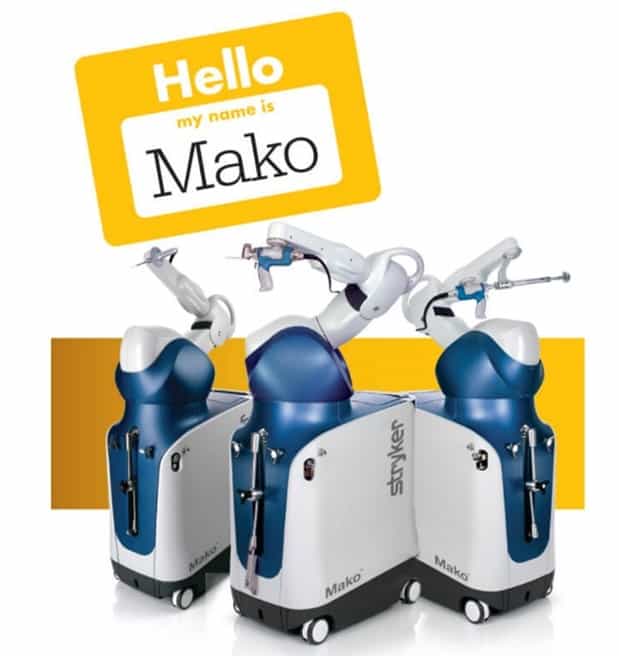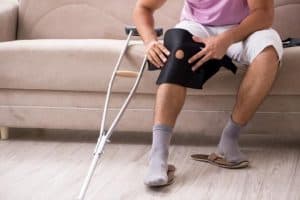Knee Replacement (Robot-Assisted) in Chillicothe, OH
How MAKO (Robotic-Assisted) Knee Replacement Works
Robotic-assisted surgical procedures enable orthopedic surgeons to perform complex procedures with more precision and control.
During robotic-assisted procedures, Dr. Cohen guides the robot’s arm to perform the procedure with exacting precision and control.

Dr. Cohen utilizes Stryker’s MAKO robotic-arm assisted technology for knee replacement procedures. The MAKO knee replacement procedure calls for a CT scan of your knee joint to be taken prior to surgery to produce a 3-dimensional virtual rendering of your knee. Dr. Cohen uses this information in conjunction with information from your case file to complete a surgical plan unique to your needs. This includes determining the size, placement and position of the knee implant.
During robotic-arm assisted surgery, Dr. Cohen guides the robotic arm to perform the surgery and insert the knee implant. The knee implant is placed based on the angle from the surgical plan and how this impacts your knee motion and stability. The robot provides a virtual boundary, or safe zone, that helps Dr. Cohen stay within the boundaries defined within the surgical plan.
Robot-Assisted Knee Replacement Benefits
Robotic-assisted procedures can have many benefits, including the following:
- Greater precision
- Greater flexibility
- Better control
- Reduced blood loss
- Less pain
- Lower revision rates
- Fewer complications
Why Choose Dr. Cohen?
OVER 20 YEARS EXPERIENCE
One of the first orthopedic surgeons employed by a large hospital. Dr. Cohen spent 20 years.
TRUSTED BY OVER 100,000+ PATIENTS WORLDWIDE
Over his distinguished career, Dr. Cohen has cultivated a reputation of excellence and trust among his patients and his peers.
UTILIZING THE LATEST TECHNOLOGY
To achieve the best surgical outcomes, Dr. Cohen utilizes the most advanced technologies and techniques, keeping his practice state of the art.
PATIENT SAFETY IS TOP PRIORITY
An individualized, patient-focused process coupled with decades of training and experience help ensure maximum safety for all of Dr. Cohen’s patients.
Partial Knee Replacement
Your knee is the largest joint in your body. There are three sections of the knee joint: inside (medial), outside (lateral), and kneecap (patella). If all three sections of the knee are diseased, a total knee replacement may be necessary. However, if only one or two sections of the knee joint are diseased, Dr. Cohen may recommend a partial knee replacement. A partial knee replacement replaces only the diseased part of the knee.
Studies have shown that more than 90 percent of patients that undergo MAKO partial knee replacement surgery are satisfied or very satisfied 5 years after surgery. Studies have also shown that patients who had MAKO partial knee replacement surgery had less pain in the days and weeks following surgery compared to those who had a traditional joint replacement.
Total Knee Replacement
 If your entire knee has been damaged by arthritis or injured, everyday activities like sitting, kneeling and walking can feel debilitating. One possible treatment for knee pain is total knee replacement, where the damaged bone and cartilage are removed and replaced with an implant.
If your entire knee has been damaged by arthritis or injured, everyday activities like sitting, kneeling and walking can feel debilitating. One possible treatment for knee pain is total knee replacement, where the damaged bone and cartilage are removed and replaced with an implant.
MAKO total knee replacement is often recommended for patients suffering from osteoarthritis, traumatic arthritis, avascular necrosis, rheumatoid arthritis or post-traumatic arthritis. Clinical studies have shown that six months after surgery, patients who had MAKO total knee replacement reported better patient satisfaction scores and lower pain scores compared to those who received a conventional joint replacement. The MAKO system has also been shown to protect soft tissue and ligaments from damage.
Robotic-Assisted Partial Knee Replacement FAQs
How Does the MAKO System Improve Partial Knee Replacement?
Traditional partial knee replacement surgery comes with a high risk of implant failure. A 2014 study published in International Orthopedics found that 53.9 percent of patients involved experienced implant failure within five years of partial knee replacement. For that reason, most doctors preferred a total knee replacement for the best outcome until MAKO became available. A two-year study published in The Knee in 2017 found that robotic-assisted partial knee replacement has a less than 1.2 percent failure rate.
In addition to drastically reducing the number of people who needed revision procedures and providing doctors a better solution than total knee replacement, MAKO offers faster recovery, enhanced surgical precision and fewer days in the hospital.
Who Is a Candidate for Partial Knee Replacement with the MAKO Robotic-Arm System?
 If you experience moderate to severe knee pain with activity or when you stand up from sitting or lying down, you may be a candidate for robotic-assisted partial knee replacement. Patients typically have pain localized in the inner knee, under the kneecap or the outer knee, and you may have knee stiffness. Non-surgical treatments such as physical therapy, anti-inflammatory medications and other methods should be exhausted before orthopedic surgery.
If you experience moderate to severe knee pain with activity or when you stand up from sitting or lying down, you may be a candidate for robotic-assisted partial knee replacement. Patients typically have pain localized in the inner knee, under the kneecap or the outer knee, and you may have knee stiffness. Non-surgical treatments such as physical therapy, anti-inflammatory medications and other methods should be exhausted before orthopedic surgery.
How Long Will My Knee Implant Last?
Robotic-assisted partial knee replacement offers longer outcomes than the manual procedure, but several factors depend on how long your knee implant lasts. Your weight will affect the implant longevity because of the stress obesity or being overweight can put on the body. Your occupation and activity level will impact your results along with bone quality and how closely you follow Dr. Cohen’s post-operative directions. MAKO provides ideal alignment and positioning, which lengthens the life expectancy of your implant. However, medical conditions and lifestyle habits may play a part.
Research suggests your knee implant may survive up to 16 years as just 8 percent of patients need revision surgery. The most common reason for revision knee surgery is implant loosening.
What is the Recovery Like from a Partial Knee Replacement with MAKO?
 Partial knee replacement with the MAKO system is minimally invasive, which reduces trauma to the knee and surrounding tissues and offers a shorter recovery. Same-day discharge is the goal.
Partial knee replacement with the MAKO system is minimally invasive, which reduces trauma to the knee and surrounding tissues and offers a shorter recovery. Same-day discharge is the goal.
You will need a cane, crutches or a walker for several weeks, though most people don’t need walking assistance after six weeks post-op. Full recovery is standard around 12 weeks. If you follow Dr. Cohen’s instructions and your rehabilitation program, daily activities such as driving can resume four to six weeks after your partial knee replacement.
What Are the Advantages of Choosing Cohen Orthopedic for My Knee Replacement?
Dr. Cohen is a board-certified orthopedic surgeon who has treated over 100,000 patients. He is considered one of the top surgeons worldwide for the MAKO robotic-arm-assisted hip and knee replacement procedures. He believes in using the latest technology to provide the best possible outcomes in the safest healthcare environment.
Schedule Your Consultation
If you are considering a partial or total knee replacement, schedule a personal consultation with orthopedic surgeon Dr. Cohen by calling or emailing his office today. With over 20 years of experience, Dr. Cohen is a well-trained surgeon who offers a customized approach to your knee replacement surgery. He has extensive experience with robotic-assisted procedures for the knee.






